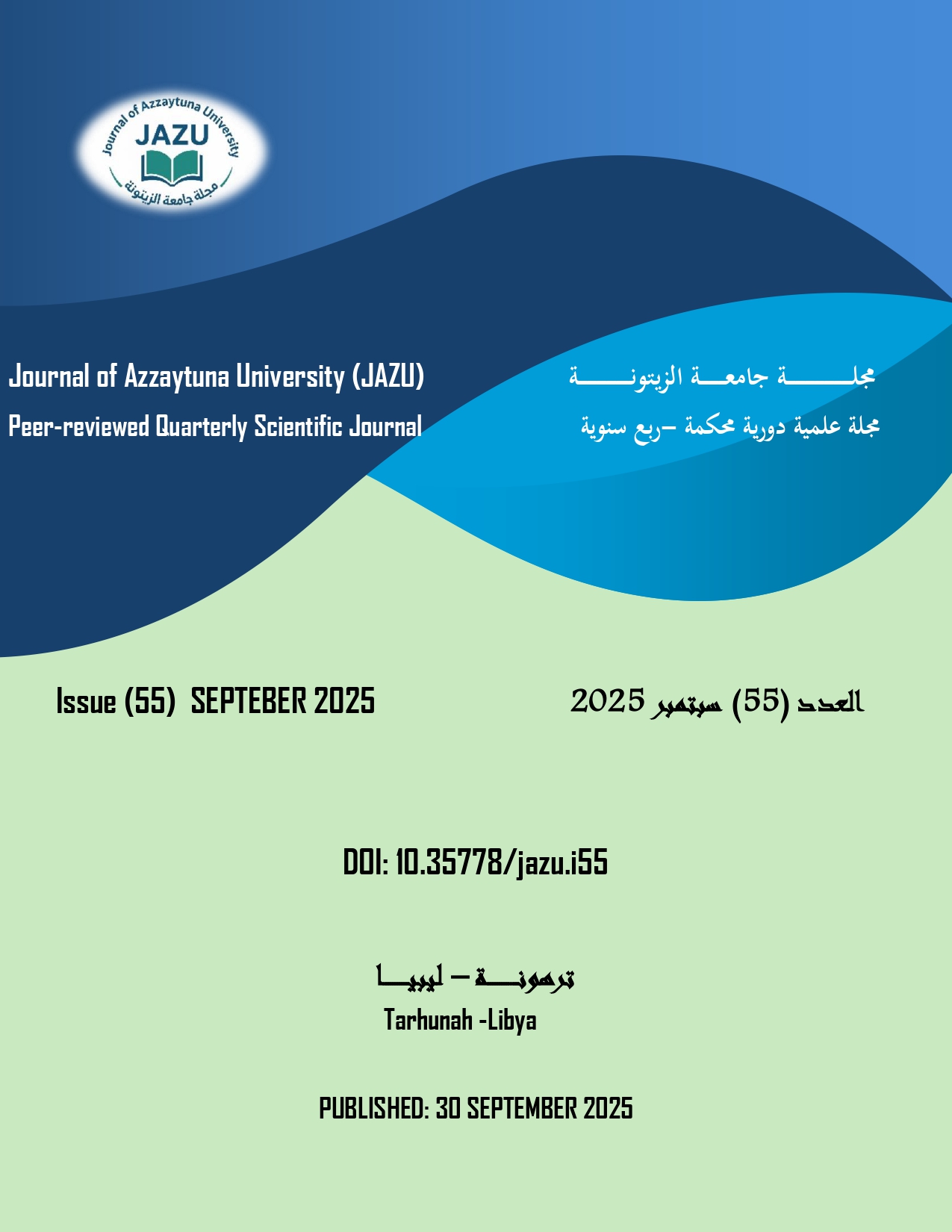مواقف طلاب الجامعات إتجاه أعضاء هيئة التدريس الذكور والاناث في جامعة الزيتونة
DOI:
https://doi.org/10.35778/jazu.i55.a565الكلمات المفتاحية:
النوع الاجتماعي؛ المعلمات؛ المدرسون الذكور؛ سلوكيات الصف؛ المناهج الدراسية؛ القيود الثقافية؛ الخلفيات الاجتماعيةالملخص
هدفت هذه الدراسة إلى استكشاف مواقف طلاب الجامعات تجاه اعضاء هيئة التدريس الاناث. وركزت الأسئلة البحثية على سبر اغوار وجهات نظر الطلاب على مستوى الاستجابة لأساليبهن التربوية من حيث طرق التدريس، والعوامل النفسية والثقافية المؤثرة فيها . تم إدراج هذه المتغيرات لما تمثله فرص التعبير عن الهوية الشخصية تحديًا كبيرًا في بيئة تفرض القيود المرتبطة بالنوع الاجتماعي، والتي قد تلعب دورًا مؤثرًا في تشكيل وتنظيم سلوكيات الصف مثل التفاعل التواصلي بين عضو هيئة التدريس و الطلاب . تمت الاستعانة بالمقابلات الشخصية المعمقة كأداة منهجية لجمع البيانات اللازمة لهذه الدراسة. كما تم الالتزام التام بالاعتبارات الأخلاقية، تفاديًا لأي آثار ضارة أو خطرة على المشاركين سواء على المدى القصير أو الطويل. اسفرت نتائج البحث عن معدلات عالية من الاداء المهني لاعضاء هيئة التدريس الاناث ٫ و بالمقابل وجود نوع من عدم الالتزام السلوكي من جانب الطلاب.
التنزيلات
المراجع
Andersen, M., & Witham, D. (2011). Thinking about women: sociological prospective on sex and gender (9thed). Boston: Pearson Education, Allyn and Bacon.
Apple, M. (1985). Teaching and Women’s Work. Journal of The Education Digest, 51, 26–29.
Apple, M. (1988). Teachers and texts: A political economy of class and gender relations in education, second Ed. New York: Routledge.
Bamora, F. N. (2010). Gender inequality in secondary education in Ghana.(Unpublished Ph D dissertation).University of Hull.
Banks, J., & Banks, C. (Eds). (2010). Multicultural Education: Issues and Perspectives. USA: John Wiley and sons, Inc.
Beilock, S.L. et.al (2010). Female Math Anxiety Effects Girls’ Math Achievement. Proceedings of the National Academy of Science of the United States of America. 107(5):
Berk, L.E. (2006). Child Development (7th ed.). Boston, MA: Allyn & Bacon.
Blumberg, R. L. (2008). The Invisible Obstacle to Educational Equality: Gender bias in textbooks. Journal of prospects, 38(3), 345-361.
Brophy, J., & Good, T. (1974). Teacher-Student Relationships: Causes and Consequences. New York: Rinehart & Winston.
Bryman, A. (2012). Social Research Methods. New York: Oxford University press Inc.
Chisamya, G., De Jaeghere, J., Kendall, N. & Khan, M. (2012). Gender and Education for all: Progress and Problems in Achieving Gender Equity. International journal of educational development, 32(6), 743–755.
Clarck, A. and Trafford, J. (1995). Boys into modern languages: an investigation of the discrepancy in attitudes and performance between boys and girls in modern languages. Gender and Education 7/3.
Eddy, S., Brownell, S., & Wenderoth M. (2014). Gender gaps in achievement and participation in multiple introductory biology classrooms. Journal of CBE- Life science education 13, 478-492. Retrieved from: http://www.lifescied.org/content/13/3/478.
Ghazvinia , S., and Khajehpoura, M. (2011). Gender Differences in Factors Affecting Academic Performance of High School Students. Procedia Social and Behavioral Sciences 15, pp 1040–1045.
Kelly, A. (1988). Gender differences in teacher-pupil interactions: A meta-analytic review. Research in Education, 39, 1–23.
Lee, J. F. K. (2014). Gender representation in Hong Kong primary school ELT textbooks – a comparative study. Gender & Education, 26(4), 356-376.
Livingstone, I. (2003). Going going? Men in primary teaching in New Zealand. New Zealand Annual Review of Education, 12, 39–74.
Margriet Van Hek, Gerbert Kraaykamp and Ben Pelzer (2017): Do schools affect girls’ and boys’ reading performance differently? A multilevel study on the gendered effects of school resources and school practices, School Effectiveness and School Improvement, DOI: 10.1080/09243453.2017.1382540. UK . Taylor & Francis Group.
Martin, A. & Marsh, H. (2005) Motivating Boys and Motivating Girls: Does teacher gender make a really difference? Australian journal of Education.
Mertens, D. N. (2005). Research and Evaluation in Education and Psychology: Integrating iversity with quantitative, qualitative, and mixed methods (2nded). California: Sage Publications, Inc.
Moreno, R., and Flowerday, T (2006). Students’ choice of animated pedagogical agents in science learning: A test of the similarity-attraction hypothesis on gender and ethnicity. Contemporary Educational Psychology, 31.2: P.186-207.
Rashidi, N., & Naderi, S. (2012).The effect of gender on patterns of classroom interaction .Journal of education, 2 (3), Scientific and academic publishing, 30-36.
Rehnman, J., & Herlitz, A. (2007). Women remember more faces than men do. Journal of actapsychologia, 124, Elsevier B. V., 344-355.
Rust, J.( 2000). The role of brothers and sisters in the gender development of preschool children. Journal of Experimental Child Psychology, 77, 292-303.
Skelton, C., Francis, B., & Smulyan, L. (Eds). (2006). The Sage Handbook of Gender and Education. London: Sage publications Ltd.
Split, J. L., Koomen, H., & Jak, S. (2012). Are boys better off with male and girls with female teachers? A multilevel investigation of measurement invariance and gender match in teacher-student relationship quality. Journal of School Psychology 50, 363-378. Retrieved from http://dx.doi.org/10.1016/j.jsp.2011.12.002
Wardhaugh, R. (1998). An Introduction to Sociolinguistics (3rded). Oxford, UK: Blackwell Publishers Ltd.
Warwick, D. and Jatoi, H. (1994) Teacher Gender and Student Achievement in Pakistan'. Comparative Education Review,38 (3).
Woolfolk, A. (2004). Educational Psychology. Boston: Pearson Education, Inc.






